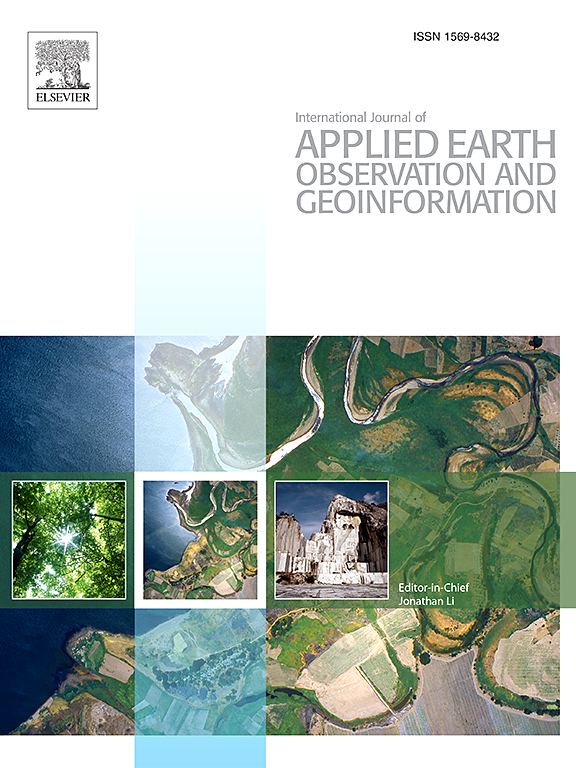LogiTide2DEM: A method for reconstructing intertidal topography in complex tidal flats using logistic regression with multi-temporal Sentinel-2 and Landsat imagery
IF 7.6
Q1 REMOTE SENSING
International journal of applied earth observation and geoinformation : ITC journal
Pub Date : 2025-04-25
DOI:10.1016/j.jag.2025.104561
引用次数: 0
Abstract
Intertidal zones are transitional areas between marine and terrestrial systems and are significant for ecological systems, socio-economic activities, and coastal erosion mitigation. However, intertidal topography is often degraded and lost by natural coastal processes and anthropogenic impacts. Accurate and frequent mapping of intertidal topography is essential for effective coastal management. Previous studies have relied on ground-based surveys or shoreline method using satellite imagery to measure intertidal topography, but these approaches are often limited in spatial extent and temporal resolution. To address these limitations, we propose LogiTide2DEM, a novel method for reconstructing intertidal topography. This method uses logistic regression to determine optimal tide heights for water-land differentiation as surface elevation using multi-temporal Sentinel-2 and Landsat imagery. The advantages of LogiTide2DEM include: a pixel-based approach rather than shoreline methods, elevation constraints using tidal height records, adaptive elevation estimation using logistic regression, and integrated quality assessment of topographic data. We applied and validated LogiTide2DEM on the Changhua coast in central-western Taiwan, reconstructing 22 years (2002–2023) of intertidal topography. Results show root-mean-square differences in elevation ranging from 0.24 m to 0.59 m, with the ratio of mean absolute error to the DEM elevation range between 11 % and 13 %, and correlation coefficients of 0.69 to 0.81. Despite a moderate omission error in water-land classification, LogiTide2DEM demonstrates robust performance in reconstructing intertidal topography. This study shows the capability of LogiTide2DEM to generate high-resolution, reliable topography spanning past decades, providing valuable insights for coastal management and research.

logtide2dem:基于Sentinel-2和Landsat多时相影像的logistic回归重建复杂潮滩潮间带地形的方法
潮间带是海洋系统和陆地系统之间的过渡区域,对生态系统、社会经济活动和减缓海岸侵蚀具有重要意义。然而,潮间带地形往往因自然海岸过程和人为影响而退化和消失。准确和频繁地绘制潮间带地形图对于有效的海岸管理至关重要。以往的研究依靠地面调查或利用卫星图像的海岸线方法来测量潮间带地形,但这些方法的空间范围和时间分辨率往往有限。为了解决这些局限性,我们提出了一种重建潮间带地形的新方法 LogiTide2DEM。该方法使用逻辑回归法,利用多时 Sentinel-2 和 Landsat 图像确定最佳潮汐高度,将其作为地表高程进行水陆区分。LogiTide2DEM 的优势包括:基于像素的方法而非海岸线方法、使用潮汐高度记录的高程约束、使用逻辑回归的自适应高程估算以及地形数据的综合质量评估。我们在台湾中西部的彰化海岸应用并验证了 LogiTide2DEM,重建了 22 年(2002-2023 年)的潮间带地形。结果显示,海拔高度的均方根差异在 0.24 米到 0.59 米之间,平均绝对误差与 DEM 高程的比率在 11 % 到 13 % 之间,相关系数在 0.69 到 0.81 之间。尽管在水陆分类中存在一定的遗漏误差,但 LogiTide2DEM 在重建潮间带地形方面表现出了强劲的性能。这项研究表明,LogiTide2DEM 能够生成跨越过去几十年的高分辨率可靠地形图,为海岸管理和研究提供有价值的见解。
本文章由计算机程序翻译,如有差异,请以英文原文为准。
求助全文
约1分钟内获得全文
求助全文
来源期刊

International journal of applied earth observation and geoinformation : ITC journal
Global and Planetary Change, Management, Monitoring, Policy and Law, Earth-Surface Processes, Computers in Earth Sciences
CiteScore
12.00
自引率
0.00%
发文量
0
审稿时长
77 days
期刊介绍:
The International Journal of Applied Earth Observation and Geoinformation publishes original papers that utilize earth observation data for natural resource and environmental inventory and management. These data primarily originate from remote sensing platforms, including satellites and aircraft, supplemented by surface and subsurface measurements. Addressing natural resources such as forests, agricultural land, soils, and water, as well as environmental concerns like biodiversity, land degradation, and hazards, the journal explores conceptual and data-driven approaches. It covers geoinformation themes like capturing, databasing, visualization, interpretation, data quality, and spatial uncertainty.
 求助内容:
求助内容: 应助结果提醒方式:
应助结果提醒方式:


